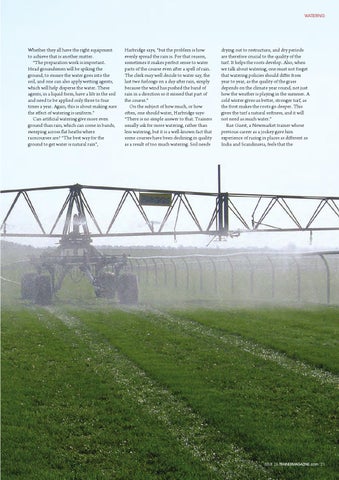WATERING.qxd:Jerkins feature.qxd
22/5/09
11:18
Page 2
WATERING
Whether they all have the right equipment to achieve that is another matter. “The preparation work is important. Head groundsmen will be spiking the ground, to ensure the water goes into the soil, and one can also apply wetting agents, which will help disperse the water. These agents, in a liquid form, have a life in the soil and need to be applied only three to four times a year. Again, this is about making sure the effect of watering is uniform.” Can artificial watering give more even ground than rain, which can come in bands, sweeping across flat heaths where racecourses are? “The best way for the ground to get water is natural rain”,
Harbridge says, “but the problem is how evenly spread the rain is. For that reason, sometimes it makes perfect sense to water parts of the course even after a spell of rain. The clerk may well decide to water say, the last two furlongs on a day after rain, simply because the wind has pushed the band of rain in a direction so it missed that part of the course.” On the subject of how much, or how often, one should water, Harbridge says: “There is no simple answer to that. Trainers usually ask for more watering, rather than less watering, but it is a well-known fact that some courses have been declining in quality as a result of too much watering. Soil needs
drying out to restructure, and dry periods are therefore crucial to the quality of the turf. It helps the roots develop. Also, when we talk about watering, one must not forget that watering policies should differ from year to year, as the quality of the grass depends on the climate year round, not just how the weather is playing in the summer. A cold winter gives us better, stronger turf, as the frost makes the roots go deeper. This gives the turf a natural softness, and it will not need as much water.” Rae Guest, a Newmarket trainer whose previous career as a jockey gave him experience of racing in places as different as India and Scandinavia, feels that the
ISSUE 26 TRAINERMAGAZINE.com 21
